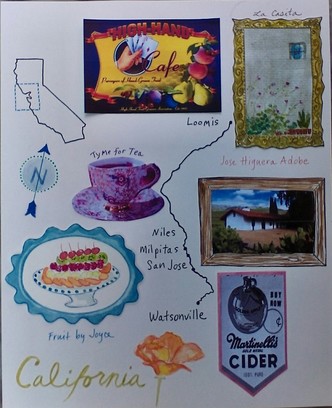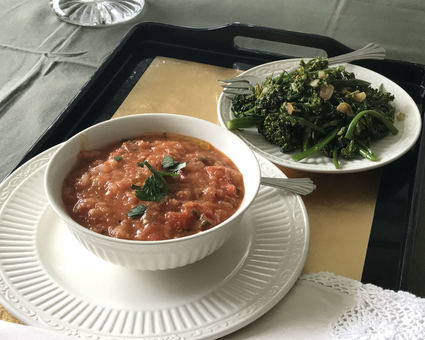Although Wayne and I now live in Hawaii, our son David, along with all of our siblings, nieces and nephews live in California. This makes at least one yearly return trip to the golden state mandatory. California’s Mediterranean climate encompasses only two seasons, winter with six months of heavy rain leading to lush green foothills dotted with golden poppies, and summer, with no rain at all until around the end of October. The hillsides grow drier and drier until the characteristic “gold” of the dead grasses covers the entire state. But the glorious California live oaks and coastal redwoods with their deep roots survive the rhythms of rain and drought and stand as ancient giant totems from south to north in this beautiful land.
When we arrived this summer, California had endured a winter of historic rains that ended an agonizing seven-year drought. The oleanders along the freeways were in bloom, and the hillsides still retained a faint touch of green. As our home base, Wayne and I rely on the generous hospitality of my brother, John Murdock and his lady friend, Mari in his home in Milpitas, just north of San Jose, the busy and congested center of Silicon Valley. Our first order of business is always a drive over the coast range to Watsonville to see our sister Margaret and her family—husband Rudy Pedulla, their adult children Peter and Kathleen, and Peter’s wife Tiffany and daughters Amanda and Molly.
There is more than one route from Milpitas to Watsonville, the best known being Highway 17, which winds through the mountains from Los Gatos to Santa Cruz with breathtaking views of the redwood forest and the Pacific Ocean as the road connects with Highway 1, the quintessential road trip venue that runs the entire length of America’s west coast. But today, we decided to head south on Highway 101 through the center of Santa Clara County and on to Gilroy’s fragrant garlic fields then west on Highway 152, past the artichoke farms and up winding Hecker Pass to Mt. Madonna. This beautiful rural journey took us through redwoods, woodlands filled with oaks and areas of low growing manzanita where quail families nest and forage for food. Hawks soared overhead as we descended into the coastal farmlands of strawberries and lettuce on the outskirts of Watsonville, an old agricultural town that has changed little in the last fifty years.
|
|
In summer sunshine,
Four cows and their newborn calves
Walk under an oak.
|
Watsonville is home to world famous Martinelli’s apple juice, and we are always treated to a glass of Martinelli’s Sparkling Cider the moment we arrive at my sister’s house. A tour of the Pedulla family rose garden is another treat. The roses were in beautiful bloom after a winter of generous rain, and the fig, lemon and orange trees in the yard were loaded with fruit. Watsonville’s proximity to the Pacific Ocean creates a cool and misty climate in contrast with the hot central valleys of California. Just about everything seems to grow in Watsonville, especially flowers and berries.

Our lunch reflected Watsonville’s agricultural abundance. To our delight, Kathleen, my niece and co-author of myteaplanner.com, drove down from her home in northern California near Redding, to join the family gathering. And she took on the responsibility of preparing the meal in her parents’ home. The dining room table, always set with cloth napkins and a tablecloth, was graced with a lovely bouquet of roses straight from the yard. The main dish, served from the table in a large colorful crock, was a local shrimp and vegetable stew, bursting with fresh herbs from the garden, summer tomatoes and squash, garlic and green onions. This lovely Mediterranean style creation was presented over a bed of couscous and other ancient grains. Plenty of California and French wine was offered along with the Sparkling Cider. While my brother was helping himself to second and third servings of the hearty shrimp stew, I spotted a gorgeous fruit cobbler in a vintage oval glass baking dish resting on the buffet. This was my cue to put down my fork and wait for dessert.
To see Kathleen’s luscious Summer Cobbler for yourself, go to our website, myteaplanner.com and search for her July 2017 blog, “The Cherry Cupboard.” There you will find Kathleen’s photograph of the very cobbler we devoured that afternoon. The bright red juices oozing out of the home-made crust came from a combination of fresh summer blackberries, bottled Morello cherries, rhubarb from the garden and ripe plums. Served with hot coffee and vanilla ice cream, this cobbler was the very essence of good times with loved ones in the long California summer.
More good times were to come when the Higashi clan gathered at the home of Wayne’s sister Joyce on a shady street in an old San Jose neighborhood. Joyce’s forte is fresh fruit salads, which she creates like glittering mosaics of cut grapes, cherries, raspberries, peaches and every other summer fruit she can find. Joyce is also a fan of Trader Joe’s, a specialty California grocery chain which we miss in Hawaii almost as much as we miss our family. Trader Joe’s does not pretend to offer every food item available. Instead, they negotiate special prices on packaged foods such as nuts, dried fruits, cheeses, cookies and holiday pastries, wines and Belgian chocolates. In other stores, many of these products are quite costly, but Trader Joe’s offers these treats at a reasonable cost, adding to the quality of life for ordinary Californians. At our Higashi potluck, we devoured a sumptuous array of imported cheeses, crackers, and condiments, compliments of Trader Joe’s.
Since my mother-in-law Misa passed, we no longer enjoy home-made beef sukiyaki cooked at the table, but Wayne’s brother Steven and his family arrived with home-cooked prime rib to satisfy the meat loving Higashis. As the family member who is always assigned the task of bringing dessert, I was faced with a bit of a challenge, as I was my brother’s house guest and wanted to follow my own advice never to take over my host’s kitchen with a potentially messy and time-consuming cooking project. (See the “Guidelines for Guests” in myteaplanner.com.) I toyed with the idea of baking a pound cake and hauling it onto the plane in a tote bag, but thought better of it in light of today’s security restrictions.

Instead, I brought a large box of assorted Honolulu Cookie Company shortbread cookies. Then Wayne and I made our own pilgrimage to Trader Joe’s the day of the potluck. There we struck gold with Trader Joe’s own Cookie Butter Ice Cream and all the fixings for make-your-own sundaes. These included jars of caramel sauce and chocolate fudge sauce, which only need a few seconds of microwaving to create hot fudge or hot caramel sundaes. A bag of dry toasted sliced almonds provided the perfect topper along with the Hawaiian shortbread cookies. But back to the Cookie Butter Ice Cream. Trader Joe’s seems to have invented the guilty pleasure known as Cookie Butter, a concoction comprised of ground Speculaas (popular Dutch crispy, caramelized spice cookies,) combined with butter and sold in a jar like peanut butter. Trader Joe’s also sells the addictive Cookie Butter Cookies, crispy round sugar cookies sandwiched together with Cookie Butter. It was only a matter of time before the marketing wizards at Trader Joe’s figured out that Cookie Butter could be added as a swirl to premium vanilla ice cream. And without spending a single moment messing up my brother’s kitchen, Wayne and I scored a dessert triumph with which even the loveable but picky Higashi clan could not find fault.
In addition to quality time with David and outings with my brother to view the gorgeous Calaveras Reservoir and the historic Higuera Adobe, both tucked into the Milpitas foothills, Kathleen and I were able to schedule an overnight Girls’ Road Trip. Our destination was the quaint little town of Loomis, east and north of Sacramento in the Sierra foothills. We were invited to visit my dearest friend, Joan Moore, a colleague from my college teaching days, now a widow in her eighties living in a new casita which she personally designed as her final residence on a beautiful plot of virgin land in rural Loomis.
The drive from Milpitas to Loomis takes only a little over two hours, depending on traffic conditions, so we took a leisurely approach. Kathleen first had to negotiate the traffic between Watsonville and Milpitas to pick me up at my brother’s house. Since she had to drive for well over an hour before our road trip even began, we decided that a respite at a tea room along the way was in order. We chose the charming town of Niles, a short distance north of Milpitas, just off Mission Boulevard. We passed the beautifully restored 1797 Mission San Jose, the fourteenth Franciscan mission built in California. Still active, the lovely old Spanish church serves as a chapel of the newer St. Joseph Church next door. Today, both the Town of Niles and the Mission neighborhood are subsumed into the busy modern city of Fremont.
|
Puffy white clouds form
Shadowy patterns on the
Golden summer hills.
|
|
The Victorian Town of Niles, located near Mission Boulevard and Alameda Creek, seems almost untouched by time as one strolls down the main street, Niles Boulevard. Niles was once home to the silent film industry, where Charlie Chaplin and Gloria Swanson made films before film making moved to Hollywood. Visitors can learn about the early history of cinema at the Silent Film Museum. The boarding platform for the Niles Canyon Railway is also located in the center of town. Another historic gem, the thirteen-mile round trip travels through scenic Niles Canyon along the first transcontinental rail connection from San Francisco east to the rest of the nation. However, our thoughts were on Afternoon Tea, and we chose Tyme for Tea, a charming traditional tea room right on Niles Boulevard.
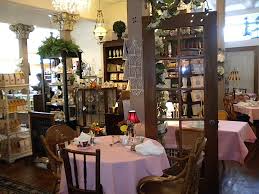
My brother’s friend Mari joined us for this leg of the journey. A fun loving former kindergarten teacher, Mari enjoys tea parties almost as much as Kathleen and I do. She and my brother found each other as widowed retirees, and the relationship has sparked new life into both of these good-hearted people who suffered through tragedy with the illness and deaths of their spouses years ago. Kathleen and I had visited Tyme for Tea previously and knew we could count on them to deliver perfectly brewed hot tea, fresh warm scones with crème fraiche, lemon curd and raspberry jam, tasty savories and delicious little sweets. Although we found the décor a bit over the top, one cannot really hold that against a Victorian-themed establishment, as excess is the very essence of the Victorian aesthetic. We did appreciate the individual floral teapots and the charming mix of rose-patterned plates and teacups on the well-set tables.
A high point of our Afternoon Tea was the attentive and very polite service. Our server brought us our hot tea from a wide selection of black, green and herbal teas, and offered to pour it for us. He was happy to provide additional hot water at our request. And he volunteered to bring us clean floral dessert plates when we switched from scones to sweets. The savories were especially tasty, particularly the mushroom pastries and the cucumber and radish sandwiches. Among the sweets were some very good petit fours filled with almond paste. Although not made on the premises, they were outstanding.

We also loved the tea-themed gift shop located in the same space as the tea room. This shop is for serious tea lovers, offering an extensive selection of china tea pots, plates, cups and saucers, attractive cake pedestals and other serving pieces, tea, stationary and cards. Many different china patterns are available, including items made by the Grace China company, which produces tea ware that is both beautiful and economically priced.
We said goodbye to Mari, who returned to Milpitas after our very satisfying Afternoon Tea, and Kathleen and I pressed on to Loomis. This cute, historic town, near the California gold country, lies between Sacramento and Auburn on Highway 80 in Placer County. Loomis was established in 1850 and was once home to the California Fruit Exchange on the Southern Pacific Railroad. In the old days, farmers brought their fruit from all over Northern California to Loomis, where the fruit was packed and shipped to far away destinations by rail. The old railway station and two of the historic fruit packing sheds, the Blue Goose and the High Hand, can still be found in the center of town. The High Hand is now a nursery and café, and well worth a visit. The nursery is famous for its gorgeous hydrangeas, but many other beautiful plants are available. The café offers good local farm food, weekend brunch and olive oils and vinegars for purchase.

This quiet old town is where my friend Joan Moore intends to spend the rest of her life. Before building her casita, Joan, an historian whose mother and grandmother both lived into their nineties, did an extensive amount of research about gerontology and methods for seniors to live independently in safe and nurturing environments. The small home she designed for herself provides physical, spiritual and aesthetic nourishment. And it displays a profound sense of historic continuity and sensitivity to the natural landscape. Joan chose the Spanish colonial aesthetic as an affirmation of the fact that California was successively owned by Spain and Mexico before joining the United States. Her new home resembles a California Mission, complete with a bell tower at the entrance to the walled interior patio, open to the stars.
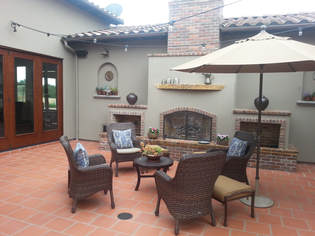
The interior patio is the jewel of Joan’s home. The adobe entrance wall, surrounded by bird feeders and hummingbirds, contains no stairs or changes of elevation. Once inside, sliding glass doors open onto the kitchen, dining and living area and a bathroom. One wall of the patio features a fire place flanked by two small waterfalls. There is also comfortable seating for reading and a table and chairs for breakfast. Flowers and succulents in containers thrive in this sunny interior space, but the patio is truly magical at night when guests can enjoy the stars and the moon after the heat of the day.

The yellow full moon
Gleams through filmy clouds onto
Red summer roses.
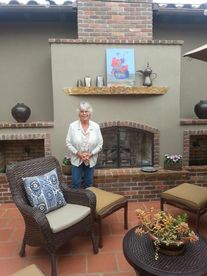
When we arrived for our overnight stay at the casita, Joan treated us to a tour of her herb and vegetable garden where she grows much of her own food. She has also planted lots of flowers, and there are some very old olive trees on the property. Joan’s daughter, Jill Walsh and her family have built a bigger home on the same large plot of land. The two homes are sited in different directions, providing both privacy and proximity. The Walsh section of the family compound includes a swimming pool to provide relief from the very hot and dry summers. This multi-generational living plan encourages family cooperation and bonding, allowing the extraverted Walshes to enjoy their sociable life style while preserving Joan’s quiet and contemplative way of life.
On the day of our arrival, Joan had prepared a stunning Middle Eastern-themed vegetarian dinner in our honor. She based her menu on recipes from The Jerusalem Cookbook, by Yotam Ottolenghi and Sami Tamimi, the Israeli and Palestinian chef team who offer harmony and cooperation through good healthy food. Gourmet cooking is another of Joan’s many talents, and among the dishes we really loved were the Butternut Squash Hummus topped with freshly toasted sesame seeds, fresh green bean salad and more squash roasted with summer vegetables and herbs. My very favorite was the starter, Tomato and Sourdough Soup, for which Joan generously provided the recipe, which you will find at the end of this blog.
Jill, her husband Jim and their son Justin joined us on the outdoor patio for this lovely and memorable dinner. Hummingbirds flocked to the feeders next to the al fresco dining table as the scent of rosemary from the herb garden filled the twilight. The pink glow of the sunset reflecting off the Sierra illuminated the evening as the stars came out and the full moon rose in the eastern sky. What a privilege it was for me and for Kathleen to spend this time together, with my dear friend and her family on this eternal California summer night.
Our Girls’ Road Trip was everything I hoped it would be, and I will treasure the time I spent with my family, my friends and my precious niece. After spending the majority of my adult life in California, the golden state will always be in my heart. As I bid goodbye for now, I would like to share a dramatic monologue I wrote many years ago that expresses some of the feelings I still cherish about California, a place like no other place on earth.
The Oak Speaks After Two Hundred Years of Silence
I haven’t been silent, really.
I have spoken every day to those who will hear and see.
When my feathery blossoms waft on the wind in March,
I herald the spring in the loudest way,
And in autumn, my acorns crash and tumble.
“Winter is coming,” they call, as they ricochet
Off pebbles and rustle through fallen leaves.
Even those who have come to live with me
Never seem to cease their speaking.
No one could call a jay quiet,
And who hasn’t been awakened by a woodpecker?
I love the chatter that never ends
As the squirrels scamper up and down my branches;
And yes, my bark can feel their funny little feet.
And yes, I do know where all their winter stores are hidden.
There are things an oak shouts out to all the world;
Other things, she can be trusted to keep secret.
I will not tell where the owl hides on the nights of no moon–
Which one of my branches harbors her.
When she calls out in her own silvery voice,
Only then will you know.
Have I seen plenty?
Of course I have.
I remember the people with quiet feet;
They would come to gather my acorns,
And always they honored me
With song and dance.
They would make their camps beneath my wide branches,
And I felt their spirits one with mine
When the great rains came
To clean my leaves, to fill their waiting baskets,
And finally, to feed my deepest roots, down, down, in the dark sweet earth.
My roots can tell so many things–
About the deep groanings
When the stones themselves shift and slip
And the quakings transform the world of light,
Moving boulders and even my brother trees,
Changing some things from the life-state
To the place of no-life.
Do I know when the quakings will occur?
If I said, “Yes,” there would soon be many
(And not the ones who honor my spirit
As the quiet feet people once did.)
Yes, many humans would come to gall me–
Worse than wasps this kind has become–
Stomping on everything with their loud feet,
They have no patience when there is something they want.
How many of my brothers have they killed
To make shelters for themselves–
Shelters too large for a whole tribe of the quiet ones.
How can I trust a people who lust and kill
And take no time to hear the wind?
Will I tell them
When my deepest roots feel the stirrings,
And even the tiny ants, my ancient friends,
Scurry and whisper of the change to come?
Like the owl, the earth is my old and secret friend;
I will tell nothing she wishes untold.
Summer Tomato and Sourdough Soup
Adapted from The Jerusalem Cookbook
by Yotam Ottolenghi and Sami Tamimi
This luscious soup, loaded with ripe summer tomatoes, onions and plenty of garlic, is perfect as a starter for a home-cooked Middle Eastern supper or as the star of a humble lunch. After our return to Hawaii, I served this wonderful soup with grilled cheese and sliced tomato sandwiches on sourdough for an everyday lunch that Wayne and I will not soon forget. What makes this soup so special is the inclusion of toasted cumin seeds and the fact that no traditional thickeners such as corn starch, flour or cream are used to enhance the texture. Instead, bits of fresh, soft sourdough bread are added when the soup is almost cooked, and the mixture is roughly pureed with an immersion blender, creating a thick, slightly chunky and very satisfying presentation. The original recipe calls for chopped cilantro as a topping, but I used Italian flat-leafed parsley, as not everyone in my family is fond of cilantro.
- 2 tablespoons extra virgin olive oil, plus extra to finish
- 1 large or two medium-sized yellow or white onions, finely chopped
- 1 ½ teaspoons fresh cumin seeds (or 1 ½ teaspoons ground cumin)
- 2-3 cloves of garlic, finely chopped
- 3 cups of vegetable stock or chicken broth
- 4 large ripe tomatoes (or 6 medium-sized,) chopped
- 1 can (14 ounces) chopped Italian style tomatoes in juice
- 1 tablespoon sugar
- 1 teaspoon salt
- ½ teaspoon freshly ground black pepper
- 2 tablespoons flat-leafed parsley (or cilantro,) chopped, plus more for garnish
- 3 slices of fresh, soft sourdough bread, crusts removed (or most of the soft center of a round loaf of sourdough bread)
Special equipment: large soup pot or Dutch oven with lid, kitchen knife, large spoon, immersion blender, ladle
Makes: six to eight servings, depending on serving size
- Heat 2 tablespoons of olive oil on medium in a soup pot or Dutch oven. Add the chopped onions and saute for about 5 minutes until translucent. Add the cumin and garlic and stir fry for about 2 more minutes, being careful not to burn the garlic.
- Pour the stock or chicken broth into the pot. Add both the fresh and canned tomatoes, sugar, salt and pepper. Stir the mixture and bring it to a gentle simmer. Cook for about 20 minutes. Taste and add more salt, pepper or cumin if you wish.
- Add the bread, torn into small chunks, and the parsley or cilantro, about half way through the cooking process. Using an immersion blender, roughly puree the soup, leaving the mixture a little coarse and chunky. To serve, ladle into bowls or cups, drizzle a little olive oil over the top, and sprinkle with additional chopped parsley or cilantro.
- This soup can be made a day early without the bread, and refrigerated. To serve later, reheat the soup, add the bread, cook briefly, and puree.





